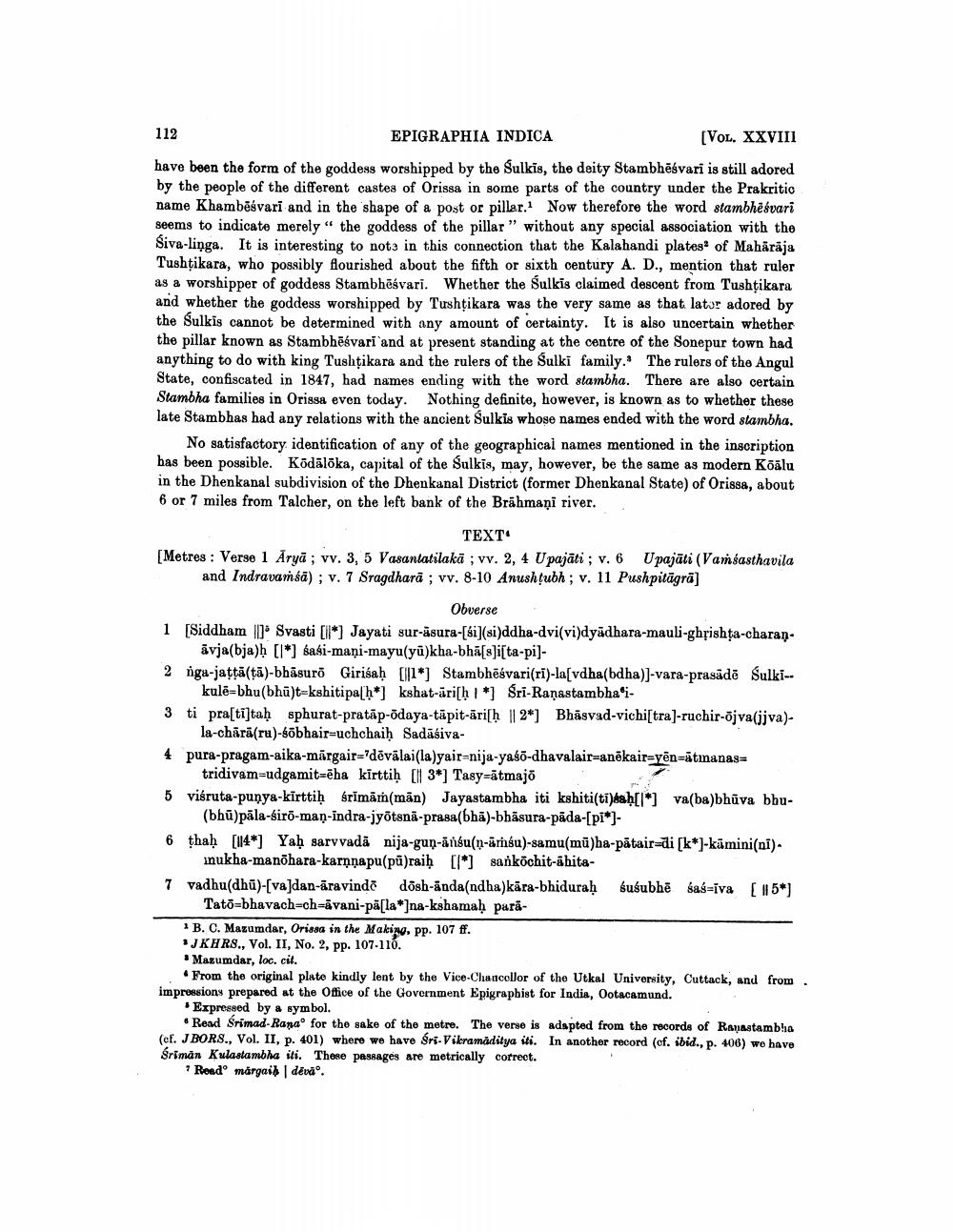________________
112
EPIGRAPHIA INDICA
(VOL. XXVIII
have been the form of the goddess worshipped by the Sulkis, the deity Stambhēsvari is still adored by the people of the different castes of Orissa in some parts of the country under the Prakritio name Khambēsvari and in the shape of a post or pillar. Now therefore the word stambhëśvari seems to indicate merely " the goddess of the pillar” without any special association with the Siva-linga. It is interesting to nots in this connection that the Kalahandi plates of Maharaja Tushţikara, who possibly fourished about the fifth or sixth century A. D., mention that ruler as a worshipper of goddess Stambhēśvari. Whether the Šulkis claimed descent from Tushţikara and whether the goddess worshipped by Tushtikara was the very same as that latar adored by the Sulkis cannot be determined with any amount of certainty. It is also uncertain whether the pillar known as Stambhēsvari and at present standing at the centre of the Sonepur town had anything to do with king Tushtikara and the rulers of the Sulki family. The rulers of the Angul State, confiscated in 1847, had names ending with the word stambha. There are also certain Stambha families in Orissa even today. Nothing definite, however, is known as to whether these late Stambhas had any relations with the ancient Sulkis whose names ended with the word stambha.
No satisfactory identification of any of the geographical names mentioned in the inscription has been possible. Kõdālēka, capital of the Sulkis, may, however, be the same as modern Köālu in the Dhenkanal subdivision of the Dhenkanal District (former Dhenkanal State) of Orissa, about 6 or 7 miles from Talcher, on the left bank of the Brāhmaṇi river.
TEXT [Metres : Verse 1 Arya ; vv. 3, 5 Vasantatilakā ; vv. 2, 4 U pajāti; v. 6 Upajāti (Vamsasthavila
and Indravamsa); v. 7 Sragdharā ; vv. 8-10 Anushubh ; v. 11 Pushpitāgrā]
Obverse 1 [Siddham (1) Svasti [114] Jayati sur-āsura-[[i](si)ddha-dvi(vi)dyadhara-mauli-ghộishta-charan.
āvja(bja)h [l*) sasi-maņi-mayu(yü)kha-bhā[s]i[ta-pi)2 nga-jattā(tā)-bhāsurő Giriśaḥ [111*] Stambhēśvari(rī)-la[vdha(bdha)]-vara-prasādē Sulki--
kulē=bhu(bhū)t=kshitipa[h*] kshat-āri[h *] Sri-Raņastambha'i. 3 ti prasti]taḥ sphurat-pratāp-odaya-tāpit-ārish || 2*] Bhāsvad-vichistra)-ruchir-õjva(jjva)
la-chārā(ru)-sõbhair=uchchaiḥ Sadāśiva4 pura-pragam-aika-mārgair='dēvālai(la)yair-nija-yaśā-dhavalair=anēkair=yên=ātinanas=
tridivam=udgamit=ēha kirttiḥ [ll 3*] Tasy=ātmajo 5 vißruta-punya-kirttiḥ srimāṁ(man) Jayastambha iti kshiti(ti)kah[l*l va(ba)bhūva bhu
(bhūpāla-siro-man-indra-jyotsnā-prasa(bhā)-bhäsura-pada-(pi*)6 thaḥ [114*) Yaḥ sarvvadā nija-gun-ansu(n-āmisu)-samu(mü)ha-pātairæði [k*)-kūmini(ni)
inukha-manohara-karnnapu(pūraiḥ [1*] sanköchit-ahita7 vadhu(dhū)-[va]dan-aravindo dõsh-anda(ndha)kāra-bhidurah susubhē sas=iva [85*]
Tato-bhavach-ch=āvani-pä[la*)na kshamah paraB. C. Mazumdar, Orissa in the Making, pp. 107 ff. *JKHRS., Vol. II, No. 2, pp. 107-116.
Mazumdar, loc. cit.
. From the original plato kindly lent by the Vice-Chancellor of the Utkal University, Cuttack, and from impressions prepared at the Office of the Government Epigrapbist for India, Ootacamund.
Expressed by a symbol.
• Read Srimad- Ranao for the sake of the metre. The verse is adapted from the records of Ranastambha (cf. J BORS., Vol. II, p. 401) where we have Sri Vikramaditya ili. In another record (cf. ibid., p. 406) we have Sriman Kulastambha iti. These passages are metrically correct.
Read märgait I dēvao.




